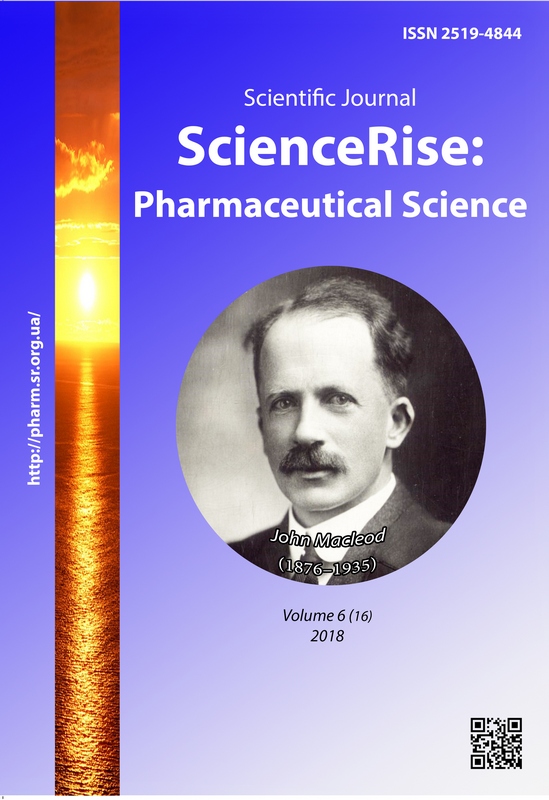Study of anthelmintic activity and acute toxicity of medicine of combined composition
DOI:
https://doi.org/10.15587/2519-4852.2018.151428Keywords:
anthelmintic drugs, albendazole, praziquantel, nematodosis, cestodosis, pharmacological studiesAbstract
Aim. The aim of the work is to investigate the anthelmintic activity and acute toxicity of the drug containing albendazole and praziquantel in the ratio (1:4) in relation to pathogens of ascariasis in pigs, toxocarosis and dipylidiosis in dogs. These pathogens belong to the class of nematodosis (ascariasis, toxocarosis) and cestodoses (dipylidiosis).
Materials and methods. The studies were carried out in the coproscopic laboratory of the parasitology department of Kharkov State Zooveterinary Academy and by the standardized method of Füllbourne and the ‘Method for the quantitative determination of helminth eggs’ (patent No. 9265). Samples for the study in dogs were obtained in the CP “Center for Animal Welfare”. In order to study the degree of toxicity of the proposed combination of albendazole and praziquantel, blood samples of pigs before and in 24 hours and 72 hours after the drug administration were taken for carrying out morphological and biochemical studies.
Results. The results obtained indicate the presence of anthelminthic activity of the studied drug in relation to pathogens of ascariasis, toxocarosis and dipylidiosis. The parameters of hematological studies in pigs free from intestinal helminthes before and after 24 and 72 hours after intake the drug were within the limits of the physiological norm. Findings of the clinical examination of the animals of the two experimental groups showed that the behavior of the animals did not change (natural), the intake of food and water was normal, the visible mucous membranes were pale pink, the skin was intact, without damage and elastic.
Conclusion. Thus, the proposed drug shows high level of anthelminthic activity in relation to pathogens of ascariasis, toxocarosis and dipylidiosis. The degree of its toxicity corresponds to “low toxic”. The obtained results indicate the advisability of the further research
References
- Dudnik, V. M., Izumets, O. I., Layko, L. I. et. al. (2011). Dіagnostika і patogenetichnі aspekti lіkuvannya gel'mіntozіv [Diagnostics and pathogenetic aspects of treatment of helminthiasis]. Modern pediatrics, 4 (38), 70–72.
- Ershova, І. B., Osichnyuk, L. M., Mochalova, G. O. (2013). Gel'mіntozi u dіtei [Helminthiasis in children]. Perinatology and pediatrics, 2 (54), 125–131.
- Samura, B. A., Babak, O. Ya., Kolesnik Yu. M. et. al.; Samura, B. A. (Ed.) (2010). Farmakoterapiya [Pharmacotherapy]. Kharkiv: Golden Pages, 800.
- Shadrіn, O. G., Koval'chuk, A. A., Dyukareva, S. V., Polkovnichenko, L. M. (2015). Stan shlunkovo-kishkovogo traktu ta shlyahi korektsіi iogo porushen' pry helʹmintozakh u dіtei [State of the gastrointestinal tract and ways of correction of its disorders in helminthiasis in children]. Modern pediatrics, 8 (72), 88–91.
- Avdyukhina, T. I., Konstantinova, T. N., Prokosheva, M. N. (2011). Sovremennyy vzglyad na problemu gel'mintozov u detey i effektivnyye puti ee resheniya [Modern view on the problem of helminthiases in children and effective ways to solve it]. Modern pediatrics, 1 (35), 73–75.
- Tolochko, K. V., Vishnevska, L. I. (2016). Basic approaches to pharmacotherapy of helminthiases and prospects of phytomedicines development for their treatment. Clinical pharmacy, 20 (4), 4–10.
- Schekina, E. G. (2007). Gel’mintozy: sovremennyy vzglyad na problemu [Helminthiasis: a modern look at the problem]. Provisor, 12. Available at: http://www.provisor.com.ua/archive/2007/N12/gelmintoza.php?part_code=62&art_code=5986
- Tolochko, K. V., Vyshnevska, L. I. (2017). Analysis of the domestic pharmaceutical market of anthelmintic medicines. News of Pharmacy, 1 (89), 56–60.
- Abbas, A., Newsholme, W. (2011). Diagnosis and recommended treatment of helminth infections. Prescriber, 22 (19), 56–64. doi: http://doi.org/10.1002/psb.814
- Kovalenko, L. M. (2014). Terapevtychna efektyvnist albendazolu pry helmintozakh svynei [Therapeutic Efficiency of Albendazole in Helminthiasis of Pigs]. Veterynarna medytsyna, 98, 144–146.
- Prykhodʹko, Yu. O. (2001). Efektyvnist albendazolu pry helmintozakh sobak [The effectiveness of albendazole in helminthiasis of dogs]. Annotation of Sumy State Agrarian University, 6, 97–100.
- Mazannyi, O. V., Byrka, V. I., Prykhodko, Yu. O. (2005). Pat. No. 9265 UA. Method of quantitative determination of helminths eggs. MPK 7, G01N 33/487. No. u200502006; declareted: 04.03.2005; published: 15.09.2005. Bul. No. 9, 6.
- Kamyshnikov, V. S. (2013). Tekhnika laboratornykh rabot v meditsinskoy praktike [Technique of laboratory work in medical practice]. Moscow: MEDpress-inform, 344.
- Herasymenko, S. S., Holovach, A. V., Yerina, A. M. et. al.; Herasymenko, S. S. (Ed.) (2000). Statistika [Statistics]. Kyiv: KNEU, 467.
- Mostovii, G. І., Dіgtyar, A. O., Garkavii, V. K. et. al. (2002). Teorіya statistiki [Theory of statistics]. Kharkiv: Vyd-vo Khar RI UA DU «Mahistr», 300.
- Prykhodʹko, Yu. O. (2000). Vyvchennia hostroi toksychnosti albendazolu na svyniakh [Study of Acute Toxicity of Albendazole in Pigs]. Veterynarna medytsyna, 77, 282–284.
Downloads
Published
How to Cite
Issue
Section
License
Copyright (c) 2019 Kateryna Semchenko, Liliia Vyshnevska, Natalia Polovko

This work is licensed under a Creative Commons Attribution 4.0 International License.
Our journal abides by the Creative Commons CC BY copyright rights and permissions for open access journals.








